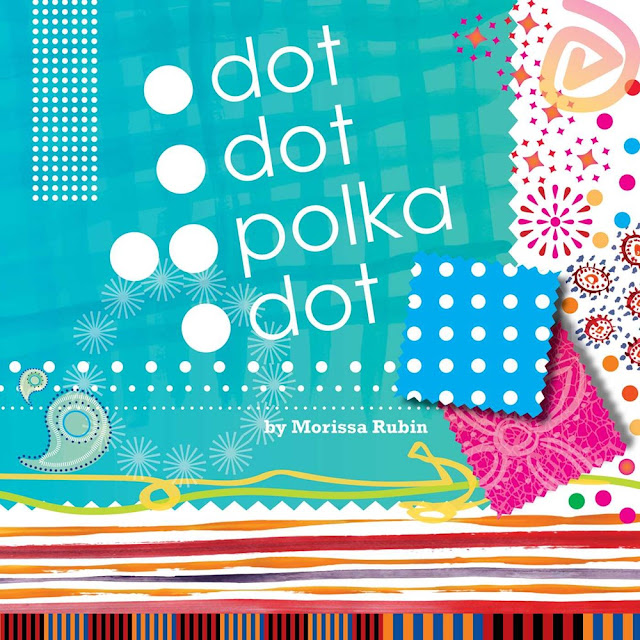I recently got a chance to catch up with author-illustrator Morissa Rubin about how she created Dot, Dot, Polka Dot, a board book that takes a unique approach to exploring the fabric patterns that make up a child's quilt. Enjoy a peek at how this book got made!
About the book:
Young readers are introduced to the shapes and movement of different fabric patterns that come together to form a child's quilt. From the swirling spirals of calico and the tidy diamond lines of argyle, to the brilliant blocks of kente cloth and Uroko's fish-like scales, Dot, Dot, Polka Dot treats children to a colorful tour of popular designs from around the world, while teaching them their unique names.
Let's talk Morissa Rubin!
LTPB: Where did the idea for Dot, Dot, Polka Dot come from, and why did you choose to tell this story through the lens of assembling a quilt?
MR: Dot, Dot, Polka Dot came about through experimentation. I did not set out to do a book about a quilt. I am a long-time graphic designer and was playing with a paint brush and thought I should make some “graphic” elements on the page. I made a few solid circles and said to myself “dot’ “dot” as I was watching them appear and then “polka dot”. I started out with dots and stripes but as I was looking to expand my repertoire, I realized that fabric patterns had some fun names that represent very specific arrangements of shapes. The idea of the quilt came somewhat later, but as soon as I had it, I knew that I had a vehicle and theme to give all these disparate patterns a reason to be in the same story.
LTPB: What did you find most difficult in creating this book? What did you find most rewarding?
MR: Because I did not have any “real” idea when I started playing around, the beginning stages came together and evolved pretty naturally. But there was a time during the process that I was struggling to make a few patterns work and I was never able to resolve those ideas satisfactorily. This was before a cohesive draft came together. At some point I accepted that I wasn’t going to include these hard-to-resolve patterns and moved on and developed a shorter version of the manuscript. There were also moments that were fun, revelatory moments like when I realized that if I include the swatch from each previous spread I could build toward the quilt and while keeping visual track (sort of an inventory) of what had been previously shown.
LTPB: What did you use to create the illustrations in this book? Is this your preferred medium in general, or was this a unique challenge?
MR: I used brush and gouache on paper for a lot of the people and animals in the book as well as for any of the free-er looking patterns. I used InDesign to create the more tidy and regular looking patterns. I also used Photoshop to edit lots of the pieces and combine various brush stroke markings. This has become a very regular work process for me. I like the freedom of the water-based paints as they allow me to work quickly and I like the spontaneity that they capture on the page. But then I still have the digital realm where I can edit, combine, layer and adjust everything.
LTPB: What are you working on now? Anything you can show us?
MR: I wish I could show you the main projects that I’ve been working on since Dot, Dot, Polka Dot, but I am currently querying those three picture book manuscripts. All of them are a bit less “concept” driven than Dot, Dot, Polka Dot, though only one of three has a more tradition narrative story. I do post visual experiments and bit and pieces of ideas on Instagram and here are a few things from there.
LTPB: If you got the chance to write your own picture book autobiography, who (dead or alive!) would you want to illustrate it, and why?
MR: This is such a great question and was SO easy for me to answer. If you had simply asked me who my favorite children’s book illustrators are, I’d have a very hard time producing a list with a finite number of names. But one of my favorite illustrators is an author-illustrator and has produced one of my all-time favorite books that happens to be a biography: Andrea D’Aquino’s A life made by hand: the story of Ruth Asawa. It is such an amazing and beautiful book. It is evocative, with simple loose gestures that say so much. The textures, patterns, scale changes and multiple viewpoints are so rich. The pages are complex and simple all at the same time. D’Aquino integrates photography, type, paint, line and collage with a humor and whimsy. It captures the wonderful contributions and the varied and interesting work of Ruth Asawa while showing us the wonderful work of D’Aquino, all in the most wonderful way.
A big thanks to Morissa for taking time to answer some questions! Dot, Dot, Polka Dot published late last year from POW! Kids Books!
Special thanks to Morissa and POW! for use of these images!

This post contains affiliate links. For more information, visit my policies & disclosures page











No comments:
Post a Comment